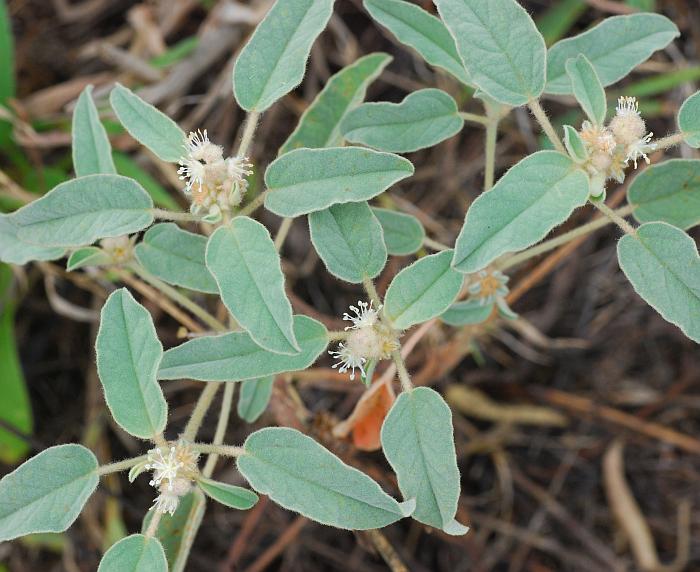Croton capitatus Michx.
Woolly Croton

Native
CC = Amb
CW = 5
MOC = 79
© SRTurner
Croton capitatus Michx.Woolly Croton | |
 |
Native CC = Amb CW = 5 MOC = 79 |
© SRTurner |
|
Family - Euphorbiaceae Habit - Taprooted, monoecious, annual forb. Sap clear. All parts of the plant densely covered with short stellate hairs having branches 0.4-1.0 mm long, often slightly unequal.
Stems - Ascending to erect, to 90 cm, branched, often with a pronounced whorl of branches above the midpoint, densely pubescent with stellate hairs.
Leaves - Alternate, petiolate. Petioles to 3 cm, densely stellate pubescent, lacking large, saucer-shaped glands at the tip. Leaf blades 2-12 cm long, lanceolate to oblong-lanceolate, triangular-lanceolate, or triangular-ovate, rounded or less commonly shallowly cordate at the base, rounded to angled or tapered to a bluntly or sharply pointed tip, the margins entire or slightly wavy below the midpoint, the undersurface usually paler than the upper surface, both surfaces densely stellate pubescent.
Inflorescence - Terminal at branch tips (the uppermost branches sometimes short and these inflorescences then appearing axillary), short, dense, spikelike racemes (often appearing headlike or as dense clusters) with pistillate flowers toward the base and staminate flowers toward the tip, the staminate flowers typically well separated from the pistillate flowers with age. Peduncles densely stellate pubescent.
Flowers - Staminate flowers with the calyx deeply 5-lobed, 0.8-1.2 mm long, the 5 petals 0.8-1.2 mm long, white to pale cream-colored. Stamens 10-14. Filaments white, glabrous, 2 mm long. Anthers whitish, 1 mm long. Pistillate flowers with the calyx 2-4 mm long at flowering, becoming enlarged to 6-9 mm long at fruiting, 6-9-lobed, densely stellate pubescent externally, lacking petals; the ovary 3-locular, the 3 styles each dichotomously lobed 2 or 3 times (the total number of stigmatic branches thus theoretically 12-24 per flower, but in practice mostly 12-16; the second and third order divisions usually well above the style base). Ovary globose to ovoid, densely stellate pubescent, 2.1 mm in diameter in flower, 3-locular.
Fruits - Fruits 6-9 mm in length and diameter, nearly spherical, persistently densely hairy at maturity, 3-seeded (rarely 2-seeded by abortion of 1 ovule), dehiscent. Seeds 3.5-5.0 mm long, circular to oblong in outline, sometimes somewhat flattened, with a caruncle. Flowering - June - October. Habitat - Glades, upland prairies, sand prairies, pastures, dry ditches, fields, farmyards, railroads, roadsides, and open, sandy, disturbed areas. Origin - Native to the U.S. Lookalikes - C. lindheimeri (uncommon in Missouri); also C. monanthogynus. Other info. - This species is found throughout Missouri, and also within a roughly circular patch extending from southern Iowa to the Gulf Coast, and from the Oklahoma panhandle to mid-Tennessee. It is attractive in its own way, but often overlooked because the flowers are not showy. It is easily identified from its overall grayish color, which is due to its dense covering of stellate hairs, and inconspicuous flowers which appear as mostly stamens. The fruits are larger than those of C. monanthogynus, but so densely hairy as to be difficult to discern as fruits. Photographs taken at Eufala National Wildlife Refuge, AL., 7-23-05 (DETenaglia); also at Shaw Nature Reserve, Franklin County, MO, 8-25-2007, and Otter Slough Conservation Area, Stoddard County, MO, 8-7-2022 (SRTurner). |